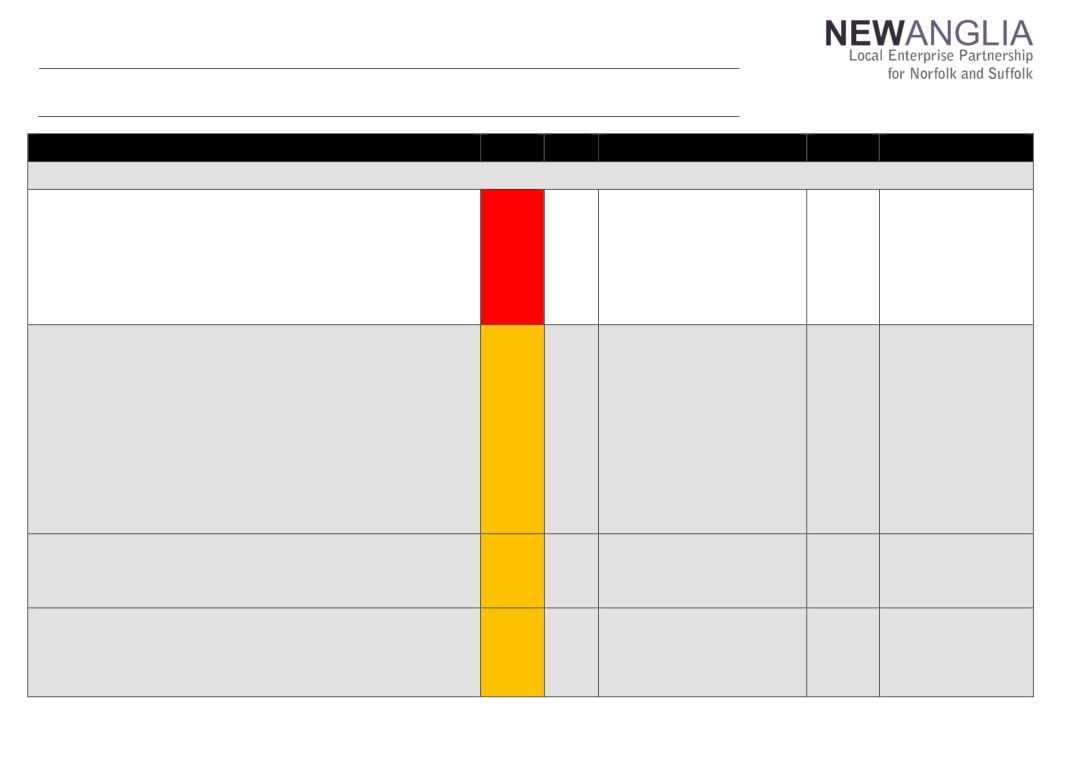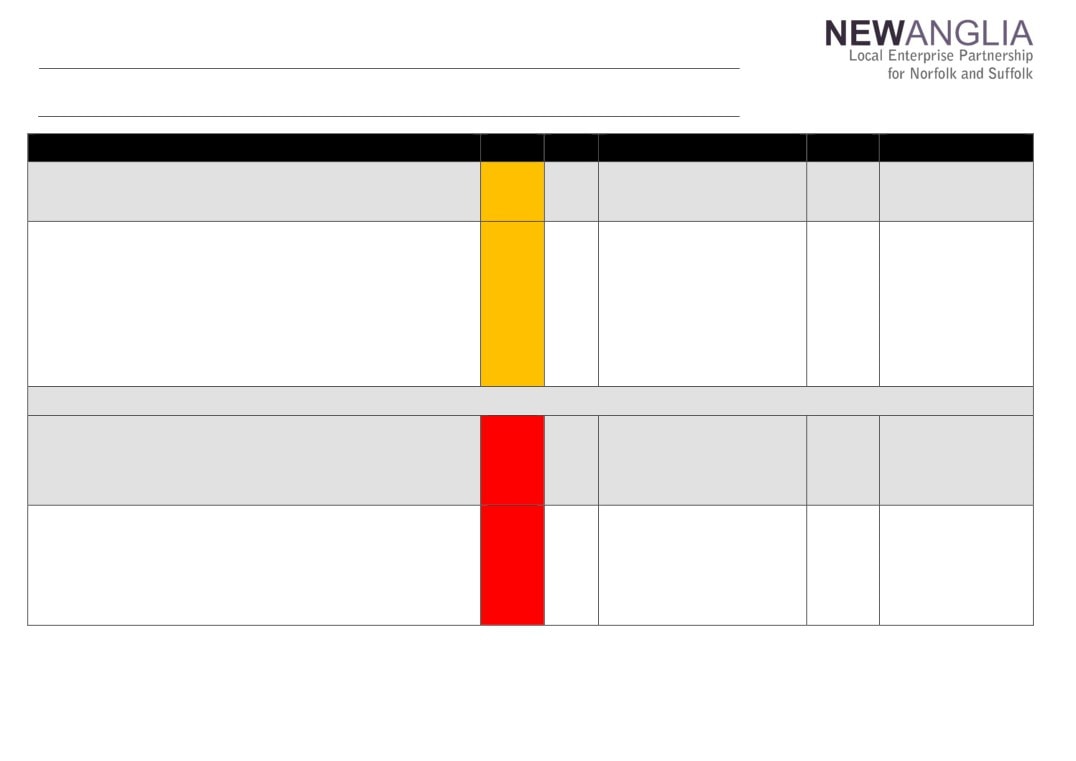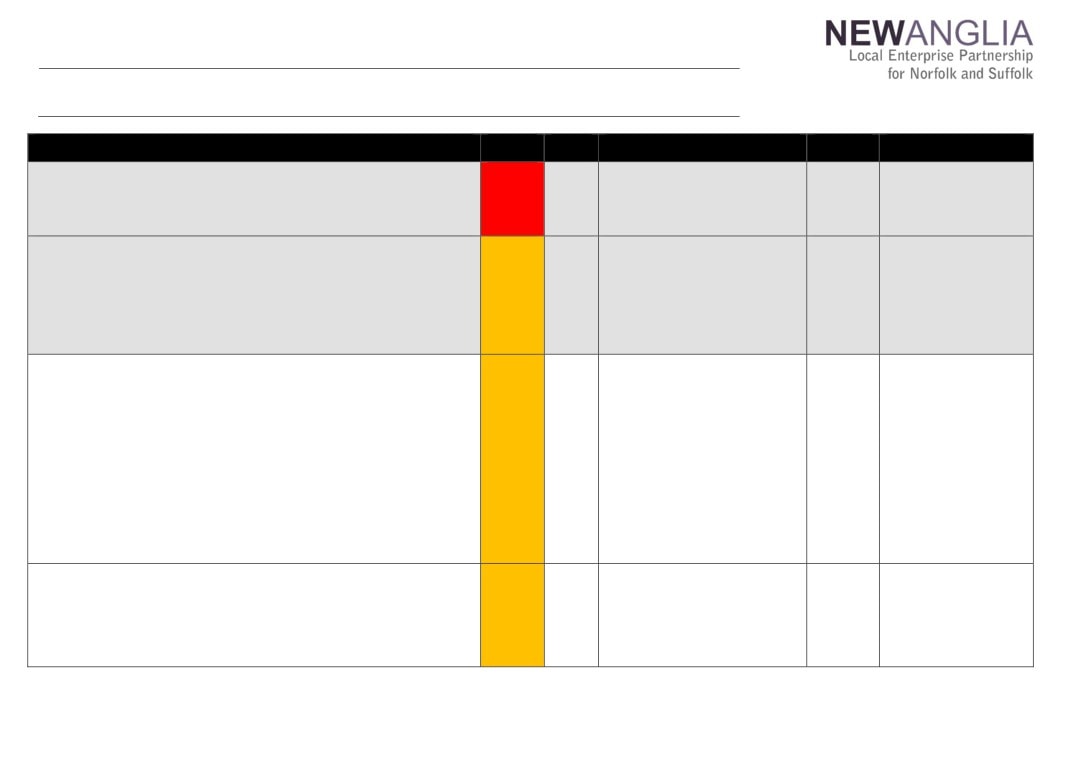New Anglia Local Enterprise Partnership Board Meeting
Wednesday 18th April 2018
10.00am to 12.30pm
The Green Britain Centre, Turbine Way, Swaffham, Norfolk, PE37 7HT
Agenda
No.
Item
Duration
1.
Welcome
15 mins
2.
Apologies
3.
Declarations of Interest
4.
Actions / Minutes from the last meeting
Forward looking
45 mins
5.
Tri-LEP Local Energy East Strategy
Presentation
6.
Cambridge-Norwich Tech Corridor Presentation
Presentation
Governance and delivery
90 mins
7.
LEP Capital Budget 2018/19 - Confidential
For Approval
8.
Review of professional advisers
For Approval
9.
Decision Log
For Approval
10.
Growth Deal Quarterly Dashboard - Confidential
For Approval
11.
Chief Executive’s report including PwC Implementation Plan
Update
12.
Finance Report including Confidential Appendices
Update
13.
Board Forward Plan
Update
14.
Any Other Business
Update
Date and time of next meeting:
10.00am - 12.00pm, 23rd May 2018
Venue: Co-op Education Centre, 11 Fore St, Ipswich IP4 1JW
1
New Anglia Board Meeting Minutes (Unconfirmed)
21st March 2018
Present:
Cllr David Ellesmere (DE)
Ipswich Borough Council
Doug Field (DF)
East of England Coop
John Griffiths (JG)
St Edmundsbury Council
Dominic Keen (DK)
High Growth Robotics
Colin Noble (CN)
Suffolk County Council
Johnathan Reynolds (JR)
Nautilus
Lindsey Rix (LR)
Aviva (via video call)
Sandy Ruddock (SR)
Scarlett & Mustard
Alan Waters (AW)
Norwich City Council
Nikos Savvas (NS)
West Suffolk College
Jeanette Wheeler (JW)
Birketts
In Attendance:
Sue Roper (SuR)
Suffolk County Council
Richard Lister (RL)
University of Suffolk (for David Richardson)
Alison Thomas (AT)
Norfolk County Council (for Cliff Jordan)
Shan Lloyd (SL)
BEIS
Chris Dashper (CD)
New Anglia LEP
Lisa Roberts (LiR)
New Anglia LEP
Chris Starkie (CS)
New Anglia LEP
Keith Spanton (KS)
New Anglia LEP
Helen Wilton (HW)
New Anglia LEP
Rachel Hood (RH)
Horse Racing Industry (For Item 4)
1
Actions from the meeting: (21.03.18)
Flood Defence Schemes
Chris Dashper to produce a brief paper on LEP funding of flood defences to be circulated to
CD
Board Members.
Institute of Technology
Board members to be provided with details of the top 3 key messages from the LEP on a
HM
monthly basis
1
Welcome from the Chair
Doug Field (DF) welcomed everyone to the meeting and thanked The Jockey Club for hosting. He
welcomed the attendees including Richard Lister deputising for David Richardson, Alison Thomas
deputising for Cliff Jordan and Rachel Hood who was presenting Item 4. Lindsey Rix joined the
meetings via video call.
2
Apologies
Apologies were received from: David Richardson, Tim Whitley, Andrew Proctor, Steve Oliver, Cliff Jordan
and Tracy Jessop
3
Declarations of Interest
Declarations relevant to this meeting:
Item 9 - Alison Thomas and Alan Waters
Item 10 - David Ellesmere, Colin Noble, Sue Roper and Richard Lister
Nikos Savvas (NS) noted the meeting that he had a personal connection to Oyster Yachts should it arise
as a future agenda item.
4
Horse Racing Industry Presentation from Rachel Hood
Rachel Hood (RH) provided the meeting with an overview of the horseracing industry in
Newmarket and its importance to the economy of the region.
The meeting was informed about the range of the industry which stretches beyond hosting
races to include breeding, training and support functions. It is the most important industry in the
area and the second biggest contributor to the economy in the East, after the Tech corridor,
employing 20,000 people directly and over 120,000 people indirectly. On a national level it
contributes £3.45bn to the economy with Newmarket the largest horseracing economic cluster
in the world.
DF thanked RH for her informative presentation and RH left the meeting.
5
Minutes of the last meeting 21st February 2018
The minutes were accepted as a true record of the meeting held on 21st February 2018.
Actions from last meeting updated as follows:
Declarations of Interest
CS
Ascertain whether regular Board substitutes need to complete Declaration of Interest Forms -
This has been confirmed and forms are being collected from those attending as substitutes.
These will be added to the web site.
Economic Indicator Trajectories and Targets
CS/JR
To receive a paper on CO2 reductions for consideration of inclusion in the economic strategy
targets - Work is ongoing and will be presented at a future Board meeting.
Brexit Analysis
To receive an action plan detailing the next steps, timescales and measures of success - Work
LiR
is ongoing and will be presented at a future Board meeting.
Governance Review
To receive a proposed scheme of delegation and decisions log at the March meeting - A
CS
Scheme of Delegation is being presented at the March Board. The decisions log will be
presented in April.
2
Flood Defence Schemes
Chris Dashper (CD) provided a verbal update on his findings and will produce a brief paper to
CD
circulate to Board Members.
6
Institute of Technology - Confidential
The Board agreed:
To note the content of the report
To support and promote the proposal and the activities of the LEP to help development
of the bid
To receive details of the top 3 key messages from the LEP on a monthly basis to assist
in getting the message to key stakeholders
7
2018/2019 Budget
CS took the majority of the paper as read and updated the meeting on the keys elements of the
2018/19 operating budget which covers the core work of the LEP and the programmes team.
Board members were advised that expenditure had increased largely due to an increase in
salaries as the LEP now has its full complement of staff. This also includes salaries for the 2
Opportunity Area staff although these costs are recovered in full.
It was noted that £150,000 has been set aside for unallocated projects giving the LEP
executive further capacity where work is expected to increase such as Brexit and the
development of a local industrial strategy
The overall impact is that the LEP is budgeting for a reduced operating surplus for 18/19 given
the certainty of almost all the income and costs.
CS provided an overview to the Projects Revenue Fund which has been established using the
Enterprise Zone revenues. The fund currently has £1m available to use in the 18/19 financial
year and CS recommended that the LEP executive develop a framework around the use of the
funds which will initially be considered by the Investment Appraisal Committee (IAC) before
being presented to the LEP Board.
The Board agreed:
To approve the operating budget for 2018/2019
To publish the approved budget in the public domain
For the LEP Executive develop a framework around the use of the revenues budget
Capital Growth Programme Bid - Snetterton Heath including Confidential Appendices 2
8
and 3
CD highlighted the key points of the proposal.
LR noted that the IAC had approved the bid but had requested that the Council reinvest the
business rates received from the project.
David Ellesmere (DE) noted that a clawback mechanism should be included should revenues
be higher than expected.
JR noted that there are many other businesses in a similar situation who would benefit from
such improvements and there was a risk that the LEP receive further similar requests.
The Board agreed:
To approved the Capital Growth Programme grant funding of £2.65m to the Snetterton
Heath Employment Areas Electricity upgrade Scheme subject to the inclusion of a
clawback clause
9
Growth Deal Funding Change Request - NATS Packages
3
Alan Waters (AW) and AT left the meeting.
CD reviewed the key points of the proposal reiterating to the Board that this was not a request
for additional funding but the reallocation of existing funding between projects.
The Board agreed:
To agree the transfer of £350,000 from NATS A11 Corridor Package to the NATS City
Centre Package.
To the inclusion of the Plumstead Road roundabout scheme into the NATS City Centre
Package and use of £400,000 of previously allocated funds.
AT & AW returned to the meeting
10
Growth Deal Funding Change Request - Cornhill
DE, Colin Noble (CN), Sue Roper (SuR), and RL left the meeting.
CS reviewed the keys points of the request for an additional £50,000 to cover a shortfall in
project funding. This contribution will leverage match funding of £350,000 already offered by
other partner organisations.
CS confirmed that this was viewed as a worthwhile project and that there was ongoing local
economic activity directly linked to the project.
The Board agreed:
To provide an additional £50k to cover the shortfall in the funding
DE, CN, SuR, and RL returned to the meeting.
11
Growing Places Fund - Atex Business Park - Confidential
The Board agreed:
To note the content of the report.
To receive a revised paper at the April board meeting
12
Scheme of Delegation
CS took the majority of the paper as read.
Board members discussed the Scheme of Delegation and agreed the following minor changes:
Page 2: Awards from Growing Business Fund up to £500k - GBP Panel “overseen by the IAC”
to be added
Page 3: Remuneration of Chief Operating Officer - CEO to be removed
Page 3: Operation procedures and policies - To be amended to “COO in conjunction with
CEO”
LiR asked whether regular update reports form the Chairs of the committees would be included
in future Board meetings.
CS agreed that this would be built into future Board plans
The Board agreed:
To approve the LEP’s Scheme of Delegation subject to the above revisions.
To receive regular updates from committee Chairs
13
Chief Executive’s report including PwC Implementation Plan
CS updated the meetings on the LEP Chairs and CEOs Workshop which he and DF had
attended on 20th March.
4
The workshop had provided further information on key areas:
Governance Review - This is expected to be completed before the summer recess and CS
advised that he felt the New Anglia was well placed to respond.
Local Industrial Strategy - New Anglia is continuing to press to be included as a pilot LEP.
Shared Prosperity fund - an update was given on the ongoing work to replace European
funding.
CS also advised that a meeting was being set up with the new Chair of the GEML Taskforce.
DF thanked the LEP executive team for their hard work which resulted in New Anglia being
assessed as a high performing LEP.
DF also advised that work was ongoing to agree the independent chair for the Audit & Risk
Committee.
AW echoed DF’s thanks to the LEP team but expressed concern that over half of LEPs were
seen as underperforming. Shan Lloyd (SL) noted that the Annual Conversations were carried
out before Christmas and that significant work had been done by LEPs since then to address
the issues raised.
The Board agreed:
To note the content of the report
14
Finance Report
KS took the majority of the paper as read and asked for questions from the Board.
The Board agreed:
To note the content of the report
15
Board Forward Plan
CS advised that the forward plan was still being developed and asked for suggestions from the
Board.
Jeanette Wheeler (JW) requested the inclusion of an update on the delivery of the housing
target.
It was agreed that updates on by Sector Leads and by Chairs on committee performance would
also be included.
The Board agreed:
To note the content of the report.
To receive the updated plan at future meetings
14
Any Other Business
None
Next meeting:
Date and time of next meeting: 18th April 2018. 10am-12.30pm
Venue: Green Britain, Turbine Way, Swaffham, Norfolk
5
Actions from New Anglia LEP Board Meetings
Date
Item
Action
Update
Actioned By
Status
21/02/2018
Declarations of Interest
Ascertain whether regular Board substitutes need to complete
Declarations will be required. Charley Purves will
CS
On-Going
Declaration of Interest Forms.
contact Board substitutes to arrange completion
21/02/2018
Economic Indicator
To receive a paper on CO2 reductions for
CS and JR liaising
CS/JR
On-Going
Trajectories and Targets:
consideration of inclusion in the economic strategy targets
21/02/2018
Brexit Analysis
To receive an action plan detailing the next steps, timescales and measures of
Draft action plan is being produced
LiR
On-Going
success
21/02/2018
Governance Review
Governance Review - To receive a proposed scheme of delegation and decisions
Decision Log presented at the April Board meeting
CS
Complete
log at the March meeting
17/01/2018
Capital Growth Programme
Identify whether other LEPS have received requests for investment in flood
Verbal update to be provided at March Board
CD
Complete
Projects
defence schemes.
meeting
22/11/2017
Business Performance
To receive a proposal on the Eastern Agi-Tech initiative by email.
On hold pending clarification on the situation at
CS
On Hold
Reports
GCGP
9
New Anglia Local Enterprise Partnership Board
Wednesday 18th April 2018
Agenda Item 5
Local Energy Strategy
Author: Iain Dunnett - Iain to present item
Summary
This paper summarises the development of the Local Energy East Network and its production
of a Local Energy Strategy and seeks comment from the LEP Board on the strategy at this
consultation stage. There will be a fuller presentation at the board meeting. The completed
strategy will be presented to the LEP Board for endorsement at the meeting in May 2018.
Recommendation
The Board is formally consulted on the Local Energy Strategy and the views of the board are
being sought on its content. The completed strategy will be presented to the LEP Board for
endorsement at the Board meeting in May 2018.
Background
BEIS funding became available nationally in March 2017 for LEPs to establish Local Energy
Networks and Strategies. Funding was secured in the East of England for a Tri LEP Network
and Strategy covering the three LEP areas of New Anglia, Greater Cambridge and
Peterborough and Hertfordshire, and their constituent local authorities. This funding secured
resources to develop a Local Energy Network and to produce a Local Energy Strategy in the
period April
2017 to April
2018. The network was led and coordinated by the Greater
Cambridgeshire and Peterborough LEP.
To support this strategy a baseline of information has been completed including Energy
Mapping, Analysis, Modelling, and the development of a Web Portal.
The Local Energy Strategy is based upon this baseline of information and is the subject of
current consultation with the aim of publishing the Strategy in June 2018. The Local Energy
East Network is seeking strategy endorsement by all local authorities and many other partners.
To this end a consultation event occurred at Newmarket Racecourse in February 2018 and
further consultation opportunities will be provided in the spring of
2018. It is particularly
important that full engagement of the strategy occurs across Norfolk and Suffolk and that the
New Anglia LEP takes the full opportunity available through this initiative to support a key
sector in the area.
The Strategy is considered to be complementary to other initiatives such as those led by the
East of England Energy Group, the Norfolk Anglian Water/UK Power Networks/Local
Authorities Utilities initiative and work being completed by the Suffolk Growth Group.
1
11
The key thematic priorities identified in the Strategy period to 2030 are as follows:
Clean Economic Growth
Housing Growth and Commercial Site Infrastructure
Secure, Affordable Low Carbon Consumption
Clean Transport Networks including Electric Vehicles
The Strategy will aim to deliver and facilitate actions in the following areas:
Business, domestic and public sector retrofit and demand reduction
Electricity generation, storage, supply and distribution
Heat generation and distribution
Transport and wider energy demand reduction
The Strategy will encompass the work of EEEGR which is actively seeking funding for the
establishment of Special Interest Groups to consider issues in the areas of distribution, storage,
community generation and smart networks and has worked with Local Energy East to establish
this initiative. The EEEGR Chief Executive is actively engaged in this subject area as the chair
of the UK Power Networks Eastern Region Critical Friends Panel which proactively engages
with local authorities, property developers, contractors and organisations representing
vulnerable customers.
A practical example of a growth location that could benefit from the strategy would for instance
be Snetterton Heath on the A11 Tech Corridor. This location has been the subject of protracted
negotiations to fully develop the site and to overcome the main obstacle to development,
namely a lack of energy capacity. There are a considerable number of sites similar to
Snetterton that will benefit from the connectivity encouraged by the Local Energy Strategy with
the consequent development of technical and financial development models rolled out across
sites with similar requirements bringing benefits of infrastructure scale, procurement and
connectivity.
Running parallel to the network and strategy BEIS have made funding available for the
development of five Energy Hubs across England. The development of a Greater South East
Energy Hub was proposed by BEIS. The eleven LEP areas in the South East, led by the
Greater Cambridge and Peterborough LEP, have coordinated a response to this proposal.
BEIS have made £1.3 million available to establish the Greater South East Energy Hub during
the period April 2018 to April 2020. The responsibility for leading the development of the Energy
Hub has now transferred from the Greater Cambridge and Peterborough LEP to the Combined
Cambridgeshire and Peterborough Authority.
The Greater South East Energy Hub is intended to:
•
Cover the area of the East of England, Greater London, the South East and the Oxford
to Cambridge Growth Corridor (16 counties plus London/11 LEPs).
•
Provide dedicated technical resource.
•
Provide project identification, feasibility, funding readiness & delivery.
•
Provide the opportunity to test, pilot, scale up and accelerate delivery.
•
Explore the use of Energy Special Purpose Delivery Vehicles.
The Greater South East Energy Hub will be fully funded by BEIS over the two year period from
April 2018 to April 2020. There is an expectation from BEIS that the hub will be self-financing
after this initial two year period, which may have financial implications for the LEPs and
partners if the hub requires further financing beyond this initial two year period.
2
12
Link to the Economic Strategy
The Local Energy Strategy aims to build upon LEP Economic Strategies.There are many links
to the New Anglia LEP Economic Strategy, the key links being:
•
The Local Energy Strategy links energy as a common theme through the LEPs
Economic Strategy to the UK Governments Industrial Strategy, Clean Growth Strategy,
the 25 Year Environment Plan and to Local Industrial Strategies.
•
Engagement with stakeholders from all the LEPs key sectors, including the energy,
construction (Building Growth) and agritech sectors, which are key sectors for the LEP.
•
Prioritizing growth location energy needs and funding in a cost efficient manner re
Growth Deal and other funding sources for
- Energy Generation and Storage.
- Grid Capacity, Supply and Distribution. Important link to UK Power Networks.
- Aggregating and Communicating Energy Investment and Procurement
opportunities across private and public partners (£10m or above investment
opportunities).
- New Energy Innovations.
•
Optimal utilization of Local, National and European funding with maximum leverage
achieved.
•
Transport and economic Infrastructure provision to facilitate enhanced energy sector
opportunities.
Develop linkage between regional centres of excellence such as Cambridge University,
University of East Anglia and the Building Research Establishment developing the
regions reputation as a centre of research, innovation and commercial development.
Building upon the Energy Sector Deals, Skills Deal, Sector Skills Plan, the regions
colleges
(in particular the new East Coast College Energy Skills Centre) and
commercial skills providers engineering development and apprenticeship programmes,
including those of the Direct Network Operators.
Recommendation
The Board is formally consulted on the Local Energy Strategy and the views of the board are
being sought on its content. The completed strategy will be presented to the LEP Board for
endorsement at the Board meeting in May 2018.
3
13
New Anglia Local Enterprise Partnership Board
Wednesday 18th April 2018
Agenda Item 6
Cambridge Norwich Tech Corridor
Author: Linn Clabburn - Linn to present item
Summary
This paper summarises and provides an update on the Cambridge Norwich Tech Corridor
(CNTC) initiative and seeks comment from the LEP Board for its planned future activities. Linn
Clabburn will provide a presentation to accompany this report at the board meeting.
The vision and the ambitions for the CNTC were agreed by the Leaders and Chief Execs of the
CNTC partner organisations on the 22nd March 2018 and the strategy and detailed delivery plan
for the initiative is currently being developed to accelerate the initiative.
Recommendation
The Board’s views, comments and support for the proposed strategy (to be presented in more
detail at the Board meeting) are sought. The Board is invited to provide views and comments
on the governance structure and recommendations on private sector representatives to join the
initiative.
Background
The CNTC was initiated in 2015 to maximise impacts from the dualling of the A11 carriageway
between Norwich and Cambridge and is a partnership between the local authorities from the
three counties along the Corridor, New Anglia LEP and GCGP LEP. The initiative seeks to work
closely with the private sector and will invite private sector representatives to join a ‘Delivery
Group’ to develop strategies and individual initiatives and interventions for the CNTC.
Feasibility studies by Bruton Knowles and Cambridge Econometrics suggest that the
Cambridge Norwich Tech Corridor area has potential for significant growth over the coming 15
years and could house an additional 46,000 people, 26,000 additional jobs, create value of an
additional £2.75bn to the economy in real terms, with workers each taking home on average an
additional £1,300 per annum, also in real terms. The Cambridge Norwich Corridor is recognised
as a Priority Place by New Anglia LEP for the significant growth opportunities that the area
offers.
The Cambridge Norwich Tech Corridor comprises not only the UK’s most established tech
cluster in Cambridge but also clusters of businesses and research excellence in a range of
tech-based sectors including:
Advanced engineering, manufacturing & materials
Agri-tech/ food-science
Life science, Med-Tech & Pharmaceuticals
IT, AI, Robotics, Sensors & Big Data
1
15
Energy
The CNTC initiative aims to join up and enhance the assets and strengths within the Corridor
area and to further develop the area into a joined up ‘corridor’ efficiently linking supply and
demand throughout the Corridor. The ultimate desired outcome of the initiative is to support and
stimulate technology-based business clusters to drive investment in new infrastructure,
commercial sites, skills, and housing to ultimately create high value jobs, increase productivity,
and GDP.
Key Considerations
The vision for the CNTC is to be a nationally recognised corridor, home to a number of
nationally significantly clusters of technology businesses with a high level of collaboration,
synergies and innovation between businesses, sectors and local economies and closely linked
to surrounding corridor initiatives. To deliver the vision of a successful corridor, the CNTC team
has developed an outline strategy for the CNTC initiative based around five key ambitions:
Cross-sector cluster development - to develop and enhance existing and emerging
technology clusters through a portfolio for clustering initiatives and to build a cross-
sector cluster to enable technology convergence and innovation and build regional
supply chains.
Skills - to support effective cluster development and inclusive growth by supporting the
Corridor area to become a leader in technical education, raising skill and productivity
levels, attract and retain a skilled workforce
Infrastructure - to support the development and investment in infrastructure to enhance
connectiveness throughout the Corridor area and enable businesses to co-locate in key
cluster locations.
Leadership - to establish leadership and provide coordination of initiatives and activities
to support cluster development and business growth.
Identity building - to build an identity and a brand for the Cambridge Norwich Tech
Corridor to drive engagement between stakeholders and provide a joined-up offer and
investment case for government, businesses and private sector investors.
The outline strategy will be presented in further detail in the Board meeting and the Board is
invited to provide feedback.
The New Anglia LEP is contributing £125k to the CNTC over a 2-year period (equivalent to
funding one senior position for 2 years).
Local authority partners are also making financial contributions.
Link to the Economic Strategy
The CNTC initiative has the potential to deliver several aspects of the Economic Strategy:
(Our offer to the world) An inward investment
‘product’ within the East inward
investment offer joining up the assets and strengths within the Corridor area to promote
several investible opportunities.
(Business growth and productivity) Facilitate the development of infrastructure required
for CNTC based businesses to grow and to attract businesses to the area.
(Our offer to the world) Showcase the opportunities and quality of life aspects of the
Corridor area to attract skilled workforce.
(Business growth and productivity) Support business growth by coordinating and
supporting access to business support, investment, etc.
(Business growth and productivity) Support business growth by building a Corridor-wide
network of supply and demand and build regional supply chains.
2
16
Next Steps
Following the approval of the outline plan on 22nd March, key milestones for the next 12 months
include;
June 2018 - appointment of private sector representatives on Delivery Group
June 2018 - ‘launch’ of CNTC initiatives to businesses in the Corridor area
August 2018 - the new CNTC website launched with detailed mapping of key assets
and opportunities in the Corridor
September 2018 - launch of Breakthrough project to support cross-sector innovation
(subject to successful funding bid)
October 2018 - showcase the CNTC at MIPIM
November 2018 - launch of the CNTC Supply Chain Development Group
2019 - first CNTC annual conference
Recommendation
The Board’s views, comments and support for the proposed strategy (to be presented in more
detail at the Board meeting) are sought. The Board is invited to provide views and comments
on the governance structure and recommendations on private sector representatives to join the
initiative.
3
17
New Anglia Local Enterprise Partnership Board
Wednesday, 18th April 2018
Agenda Item 8
Review of professional advisers
Author: Marie Finbow - Chris Starkie to present item
Summary
The LEP’s current procurement practice for buying in professional advisers is time-consuming
and lengthy. It is proposed to develop a procurement framework and create a list of Approved
Suppliers which would enable the LEP to purchase these services without the need for
individual procurement processes. This process would facilitate greater scrutiny and
transparency, and provide the structure and framework for good procurement practice, driving
good practice and behaviour as well as ensuring value for money.
Recommendation
The Board is recommended to approve the proposed approach to developing a multi-supplier
procurement framework and developing a list of Approved Suppliers of professional support
services.
The board is also recommended to approve a re-tendering exercise for the LEP’s annual audit
from the 2019/20 financial year.
Background
Currently the LEP carries out procurement for professional advisers, such as ICT, consultancy,
legal and other professional advice on an ad-hoc basis.
Choosing specialist suppliers can take a huge amount of time and effort, with each needing to
be procured individually through the LEP’s procurement policy.
To speed up this process, it is proposed to develop and maintain a list of approved suppliers.
These are ‘superstar’ suppliers who have been successful in a tender exercise for specialised
professional support services and which the LEP has thoroughly assessed and reviewed and is
willing to negotiate with on its own terms.
The primary purpose of the approved suppliers list is to ensure the placement of purchase
orders or contracts are limited to those suppliers that meet the LEP’s established criteria for
supplier selection, evaluation, and re-evaluation.
Key Considerations
An ‘approved suppliers list’ can be an informal list of suppliers that have demonstrated an ability
to provide goods/services in the past, or a more formal list of suppliers resulting from the award
of a procurement framework agreement.
1
23
It is proposed to use both approaches, developing and maintaining two lists - firstly an informal
‘open’ list of suppliers for procurement up to the value of £25,000. This would be run on a fair
and formal process, providing the opportunity for new suppliers to join on an annual basis.
Secondly for any procurement above £25,000, it is proposed to develop a multi-supplier OJEU
compliant procurement framework. This is an agreement put in place with a range of pre-
approved providers that enables the LEP to place orders for services without the need to
undertake costly and time-consuming full OJEU procurement processes. This is a ‘closed’ list of
suppliers, which once established offers no opportunity for new suppliers to join for 3 to 5 years.
A framework agreement does not bind the LEP to purchase goods or services. It sets out the
terms and basis upon which contracts will be awarded in the future. In order to purchase goods
or services under a framework agreement the LEP will take an additional step to award a
distinct call-off contract in accordance with the terms of the framework agreement. It is the call-
off contract that constitutes a binding legal obligation on the LEP.
The procurement framework will be divided into ‘lots’ - these are categories of professional
advisers which the LEP wants to buy, such as legal, consultancy, evaluation, HR, ICT,
professional advice, etc.
Through the Framework, contracts will be awarded to pre-approved suppliers through mini
competitions in line with the LEP’s Procurement Procedures (Appendix 2) and follow the
principles of best value, non-discrimination, equality of treatment and transparency.
In order to be appointed to the Approved List, suppliers will need to demonstrate that they have
the capacity and expertise to carry out a broad nature of work and a full tender process is
needed for suppliers to gain a place on the Framework.
Although there is never a guarantee of work even if suppliers are part of a Framework
Agreement, being awarded a place on the framework is a sign to others that their business is a
key player in the industry.
As part of the process we would look to encourage local suppliers, particularly SMEs to
participate and would engage with local trade groups such as the chambers of commerce and
the FSB to advertise the opportunity and benefits of being part of our approved suppliers list.
Over time, procurement frameworks can deliver many benefits, including reducing overall
procurement costs and internal resources; building of long term relationships between the LEP
and its suppliers, particularly local suppliers; providing better long-term value for both the LEP
and its suppliers; capture of knowledge and best practice; ability to commence projects early
based on limited information; as well as aligning procurement practice with government
efficiency agendas and expectations of auditing bodies.
Another key advantage of developing an OJEU compliant procurement framework is that it
could be used by other LEPs, allowing them to benefit from quicker procurement processes and
reduced procurement costs. However, this is only possible if it is written into our Framework at
the outset.
The Approved Suppliers List will be reviewed on an annual basis, allowing the LEP to make
necessary adjustments or replacements of under-performing suppliers.
A draft process for the Approved Supplier List is attached as Appendix 1.
2
24
Re-tender of LEP auditors
Separate to the development of the framework, the executive team is also recommending the
re-tender of the LEP’s annual audit for the 2019/20 year.
Lovewell Blake have been the LEP’s auditors since the formation of the LEP in 2012. A
competitive exercise was run then by the LEP to select the auditor. It is best practice to run a
retendering exercise every few years, and the LEP executive is recommending running a
retendering exercise in line with the LEP’s procurement policy. The process will commence in
the summer of 2018.
Link to the Economic Strategy
The development of a framework will support our Driving Business Growth and Productivity
theme. It will specifically support our ambition to open up supply chain opportunities for local
companies.
It will also indirectly support the Economic Strategy. Streamlining the processes for
procurement, whilst ensuring transparency and accountability, will improve the operational
efficiency of the LEP.
Next Steps
Before developing a procurement framework and a list of approved suppliers of professional
advisers, the LEP will establish criteria for selection, evaluation and re-evaluation of suppliers.
The LEP will also develop its own Terms and Conditions and invitation for the Approved List.
Recommendation
The Board is recommended to approve the proposed approach to developing a multi-supplier
procurement framework and developing a list of Approved Suppliers of professional support
services.
The board is further recommended to approve a retendering exercise for the annual audit.
3
25
Appendix 1
Approved Suppliers List for Professional Advisers
Process
Suppliers currently providing professional support services to the LEP will be invited to
apply to for the Approved Suppliers List and join one lot or multi lots.
To ensure fairness and transparency, an open invitation to apply for the Approved
Suppliers List will be published on the LEP’s website.
Approved suppliers will be notified in writing once they have been accepted on the
Approved Suppliers List.
The list of approved suppliers will be published on the New Anglia LEP website.
New Anglia LEP will review the evaluation criteria for entry onto the Approved Suppliers
List on an annual basis and if any changes are made to the criteria, existing suppliers
will be asked to provide additional information.
At the end of each year all suppliers who are on the Approved Suppliers List will have
their performance and scores reviewed based on the quality of quotes and performance
delivering any projects. Where we consider suppliers have consistently been unable, or
unwilling, to meet our requirements over the course of the year we will remove suppliers
from the Approved Suppliers List.
Suppliers being removed from the Approved Suppliers List will be notified in writing and
will have two weeks to appeal against the decision.
New suppliers wishing to join or re-join the Approved Suppliers List will be asked to
provide information to support their application in line with the Invitation to join the
Approved Supplier List and will be evaluated against the appropriate criteria.
No time limit has been placed on the termination of the LEP’s Approved Suppliers List;
this will be reviewed on an annual basis.
The terms and conditions for the Preferred Supplier List will be as attached in the terms
and conditions document. These terms will apply to all work carried out under the
Preferred Supplier List.
The scope of work, price and timescales will be agreed on a project-by-project basis
and will in no way amend the terms and conditions that override this whole agreement.
A record of results of evaluations will be maintained - which will include any necessary
actions taken as a consequence of the evaluations conducted, such as the removal of a
supplier from the Approved Suppliers List.
4
26
Appendix 2
New Anglia Local Enterprise Partnership
Procurement Procedures
Last Updated 01-11-16
Introduction
New Anglia LEP maintains a purchasing and procurement policy whereby all purchases
must be approved according to the rules outlined by these procedures. Procurement
exercises must be reviewed and approved by a member of the Senior Management Team
and in accordance with the thresholds outlined and within the law as set out by The Public
Contracts Regulations 2015.
Estimating Contract Values
The value of a proposed Contract must be estimated before undertaking a procurement
exercise as this will determine which rules apply. The value of a contract is the estimated
consideration to be paid over its full term and not simply the estimated annual expenditure,
therefore a three year contract at £50,000 per year has a value of £150,000. The amounts
quoted are gross values (i.e. total estimated cost to the LEP before any deductions) for the
full period of a contract and all exclude VAT and other taxes.
Contracts of a similar nature must not be artificially split into different parts to avoid the
application of a contract threshold. At the same time, contracts of a recurring or similar
nature must be joined together into one contract and valued accordingly. If there is any
doubt as to whether contracts must be aggregated, advice must be taken from the LEP’s
Programmes Manager. However, in some circumstances it may be permissible to
separate requirements into smaller contracts (only if there is a good reason) and providing
that if these contracts opportunities are then competed in line with EU OJEU rules. If in
doubt, procurement will follow the procedures for the highest contract value to ensure
compliance.
Before undertaking a procurement, the officer must consider whether a subsequent
contract (such as, for instance, future phases in a works programme where only the initial
phase is the subject of the immediate procurement) may be awarded to the successful firm
by negotiation and without further competition, in the event of the successful firm
completing the initial phase satisfactorily.
1
27
Appendix 2
Procurement Procedure
Contracts will be entered into pursuant to or in connection with the project’s functions and
shall comply with any applicable statutory provisions and relevant EU rules. The eligibility,
financial standing and technical capacity of contractors must be evaluated and recorded.
Procurement must follow the principles of best value, non-discrimination, equality of
treatment and transparency. The following contract value thresholds apply: -
Estimated value
Action
See Page
Under £2,500
Evidence retained to show that Value for Money
Page 3
has been obtained through a price comparison
£2,500 - £25,000
At least 3 written quotes from suitable suppliers,
Page 3
using full tender procedure, if appropriate
Above £25,000 but
Complete a full tendering procedure
Page 3
below OJEU
Thresholds
Above OJEU
OJEU regulations must be followed
Page 6
thresholds
Contracts for Supplies - £164,176 (€207,000)
Contracts for Services - £164,176 (€207,000)
Contracts for Works - £4,104,394 (€5,225,000)
As part of the procurement process, officers
must check the latest current OJEU thresholds
Record Keeping
This applies to all tenders of any value
Page 8
NOTE: For EU funded activity, any procurement above £2,500 must be accompanied with
an “On The Spot Verification Visit Procurement Check Record (Above and below OJEU)
ESIF-Form-4-014” and submitted with the evidence required.
Procurement below OJEU Thresholds
Contracts that are not subject to OJEU requirements must be conducted in line with
procurement best practice and also in line with the principles of the EC Treaty and within
EU Regulations and UK law, to afford fairness, competition and transparency in public
procurement.
Any procurement, regardless of the value there needs to sufficient advertising to enable
competition amongst suppliers. And that the procurement procedures followed must be fair
and transparent.
2
28
Appendix 2
Contracts under £2,500
Low value purchases of under £2,500 must have documentary evidence, which must be
retained to show that Value for Money has been obtained (e.g. through a price
comparison). Where possible, it is advised that written quotes, or cost comparisons are
obtained from three different suppliers, with records of quotes retained.
Contracts between £2,500 and £25,000
For purchases above £2,500 but under £25,000 written quotes should be obtained from at
least three suppliers. Quotes should be in response to clearly defined requirements and
the requirement given to suppliers must be the same in all cases.
Quotes should be received in writing and the supplier meeting the requirement and the
Most Economically Advantageous (MEA) offering selected. The minimum minimum
number of quotes is three, however, it may be beneficial to obtain more quotes in a
competitive market. If requirement falls below the £25,000 threshold but is considered to
be a high risk it may be worth completing a full tendering process as one would for above
the £25,000 threshold detailed in the section “Above £25,000 but below OJEU
Thresholds”.
In exceptional circumstances there may be a contract specification that is considered to be
so specialist as to limit the number of suppliers who may be able to quote. In such
circumstances a full record will be kept detailing the research undertaken to arrive at this
conclusion. A member of the leadership team will be required to approve this in such
circumstances.
For EU funded activity, any procurement above £2,500 must be accompanied with an “On
The Spot Verification Visit Procurement Check Record (Above and below OJEU) ESIF-
Form-4-014” and submitted with the evidence required.
Above £25,000 but below OJEU Thresholds
Tenders above £25,000 should be advertised adequately in order to promote open and fair
competition. When valuing the requirement it is vital to bear in mind that it is the overall
value of the total requirement (the total consideration payable) that is important, not the
value of individual contracts. It is not permissible to try and break down a requirement into
smaller constituent requirements in order to by-pass the constraints imposed on
procurement.
3
29
Appendix 2
Tenders must be invited by way of a written Invitation to Tender and where appropriate,
sought through an Electronic Tendering System (ETS), which in the case of the LEP will
involve publishing the tender on the Contracts Finder website
and opened through the system at the relevant deadline.
Suppliers must be given a reasonable timeframe for responding to the requirement and
preparing a quote, therefore, a minimum of thirty-five days notice must be given.
However, in exceptional circumstances, there may be a case for this time period to be
shortened. If this is to be done, there must be a justified case that is approved by the
Managing Director. In such circumstances, a minimum of fifteen days notice must be
given.
When analysing quotes, the purchaser should look out for any hidden costs or terms that
are not in the best interests of the Institution. Examples of hidden costs may be
maintenance payments or automatic renewal for subscription services.
If necessary a pre-qualification process can be put into place in order to restrict the
number of suppliers that will be receiving an Invitation to Tender. Qualification should be
based on the capacity and capability of suppliers to fulfil the requirement as opposed to
any specific parts of the requirement. If a pre-qualification process takes place, at least
three suppliers should be taken forward to the Tendering stage. The selection criteria
should be, proportionate, objective and the selections justifiable.
A Tender Assessment Form should be prepared at the point that invitations to tender are
published. It is essential that the assessment criteria and weightings of the document are
agreed at this stage and an Assessment Panel appointed, comprising individuals qualified
to critically and objectively assess tender submissions against the
requirements/specifications within the Invitation to Tender.
Tender submissions received after the stated deadline should be recorded on the Tender
Assessment Form and rejected from the assessment process. Similarly, submissions
which do not meet the requirements set out within the Invitation to Tender should be
recorded within the Tender Assessment Form and rejected from the assessment process.
Submissions meeting requirements should be recorded within the Tender Assessment
Form and included in the assessment process.
The Assessment Panel should meet to assess tender submissions, each member using a
copy of the Tender Scoring Sheet to evaluate and score each tender submission against
the requirements/specifications within the Invitation to Tender.
4
30
Appendix 2
The Assessment Panel is subject to declarations of interest. These must be declared prior
to the assessment of tender submissions. Any such panel members should be substituted
for another suitably-qualified individual. A declarable conflict of interest is a set of
circumstances that creates a risk that professional judgment and actions regarding and
influence of a primary interest - the business of the Assessment Panel - will be unduly
influenced by a secondary interest. For these purposes, secondary interests include
financial/pecuniary interests and strategic interests relating to a third party.
Assessment Panel members must declare an interest if they are or become aware that
they have or may have a financial or other beneficial interest in the outcome of a
procurement exercise being considered.
At the conclusion of the assessment, the individual scores assigned should be transposed
from the individual Tender Scoring Sheets into the three Tender Score Matrices within the
Tender Assessment Form. The totals should then be transposed into onto the Collated
Tender Score. The highest scoring tender will be deemed successful, provided it has met
the minimum requirements outlined in the Invitation to Tender.
The name of the successful tendering party should be recorded in the Tender Assessment
Form, any specific conditions/queries noted and the document signed off by all members
of Assessment Panel.
All parties submitted tenders should be contacted via email to notify them of the outcome
of the assessment process and a contract agreed. A fully documented audit trail of the
procurement process, including original signed documentation, is to be retained within
project files and managed in accordance with document retention procedures.
For EU funded activity, any procurement above £2,500 must be accompanied with an “On
The Spot Verification Visit Procurement Check Record (Above and below OJEU) ESIF-
Form-4-014” and submitted with the evidence required.
Procurement above the OJEU Thresholds
OJEU applies when the total estimated value of a contract is more than the EU Thresholds
(£164,176 (€207,000) for Supplies, £164,176 (€207,000) Services and £4,104,394
(€5,225,000) for Works), then the EU Public Procurement Rules apply. In these cases a
minimum of five EU Tenders must be sought. As part of the procurement process, officers
must check the latest current OJEU thresholds.
5
31
Appendix 2
When the estimated value of a contract is above the EU (OJEU) threshold the full
regulations governing procurement apply. When valuing the requirement it is vital to bear
in mind that it is the overall value of the total requirement (the total consideration payable)
that is important, not the value of individual contracts. It is not permissible to try and break
down a requirement into smaller constituent requirements in order to by-pass the
constraints imposed on procurement.
OJEU Tenders must be invited by way of a written Invitation to Tender and sought through
an Electronic Tendering System, which in the case of the LEP will involve publishing the
be necessary to publish a notice in the Official Journal of the European Union (“OJEU
Notice”). Only firms who express interest in the OJEU Notice in the manner stipulated in
that OJEU Notice may be invited to tender. EU Tenders must be returned and opened
through this system at the relevant deadline. Invitation to Tender is a detailed
procurement-specific document.
It should be noted that it is it permissible to separate requirements into smaller contracts (if
there is good reason) if these contracts opportunities are then competed in line with EU
OJEU rules. Failing to do this could be regarded as an attempt to deliberately
disaggregate the requirement, hence this practice is prohibited under the EU Procurement
Regulations.
Invitations to tenders should be issued using the LEP’s Invitation to Tender Template and
advertised via media with adequate scope and relevant audience for thirty-five days (30 if
the process is being conducted electronically, i.e. via email)*. Advertising channels should
include New Anglia LEP social media and third party tenders websites, particularly the
If necessary a pre-qualification process can be put into place in order to restrict the
number of suppliers that will be receiving an Invitation to Tender. Qualification should be
based on the capacity and capability of suppliers to fulfil the requirement as opposed to
any specific parts of the requirement. If a pre-qualification process takes place, at least
three suppliers should be taken forward to the Tendering stage. The selection criteria
should be, proportionate, objective and the selections justifiable.
A Tender Assessment Form should be prepared at the point that invitations to tender are
published. It is essential that the assessment criteria and weightings of the document are
agreed at this stage and an Assessment Panel appointed, comprising individuals qualified
to critically and objectively assess tender submissions against the
requirements/specifications within the Invitation to Tender.
6
32
Appendix 2
Tender submissions received after the stated deadline should be recorded on the Tender
Assessment Form and rejected from the assessment process. Similarly, submissions
which do not meet the requirements set out within the Invitation to Tender should be
recorded within the Tender Assessment Form and rejected from the assessment process.
Submissions meeting those requirements should be recorded within the Tender
Assessment Form and included in the assessment process.
The Assessment Panel should meet to assess tender submissions, each member using a
copy of the Tender Scoring Sheet to evaluate and score each tender submission against
the requirements/specifications within the Invitation to Tender.
The Assessment Panel is subject to declarations of interest. These must be declared prior
to the assessment of tender submissions. Any such panel members should be substituted
for another suitably-qualified individual. A declarable conflict of interest is a set of
circumstances that creates a risk that professional judgment and actions regarding and
influence of a primary interest - the business of the Assessment Panel - will be unduly
influenced by a secondary interest. For these purposes, secondary interests include
financial/pecuniary interests and strategic interests relating to a third party.
Assessment Panel members must declare an interest if they are or become aware that
they have or may have a financial or other beneficial interest in the outcome of a
procurement exercise being considered.
At the conclusion of the assessment, the individual scores assigned should be transposed
from the individual Tender Scoring Sheets into the three Tender Score Matrices within the
Tender Assessment Form. The totals should then be transposed into onto the Collated
Tender Score. The highest scoring tender will be deemed successful, provided it has met
the minimum requirements outlined in the Invitation to Tender.
The name of the successful tendering party should be recorded in the Tender Assessment
Form, any specific conditions/queries noted and the document signed off by all members
of Assessment Panel.
All parties submitted tenders should be contacted via email to notify them of the outcome
of the assessment process and a contract agreed. A fully documented audit trail of the
procurement process, including original signed documentation, is to be retained within
project files and managed in accordance with document retention procedures.
For EU funded activity, any procurement above £2,500 must be accompanied with an “On
The Spot Verification Visit Procurement Check Record (Above and below OJEU) ESIF-
Form-4-014” and submitted with the evidence required.
7
33
Appendix 2
Record Keeping
Any written records relating to a procurement exercise, whether kept under these Rules or
otherwise, should be retained for a period of at least six years from the expiry of the
Contract. Records may, so far as they relate to unsuccessful quotations or tenders, may
be electronically scanned or stored by some other suitable method after 12 months from
the award of the contract, provided there is no dispute about the award.
An external funder may impose different requirements in this respect and this should be
checked if any such funding is being provided.
New Anglia LEP will regularly review applicable OJEU thresholds and update this policy as
required to comply with UK Law as well as EU Regulations.
8
34
New Anglia Local Enterprise Partnership Board
Wednesday 18th April 2018
Agenda Item 9
New Anglia LEP Decision Log
Author: Chris Starkie
Summary
This paper introduces the LEP’s new Decision Log, which will record decisions made by the
LEP’s key boards and committees.
This is being introduced as part of the implementation of the PwC review of operations and
governance and follows the board’s adoption of the scheme of delegation at March’s board
meeting
Recommendation
The board is asked to endorse the LEP’s new decision log.
Background
The PwC review of operations and governance recommended the development of a decision
log which would enable decisions made by the key boards and committees to be recorded in a
single document.
This log will record decisions made by the LEP board, the LEP’s investment Appraisal
Committee, the Remuneration Committee, the Audit and Risk Committee and the Growing
Business Fund Panel.
Decisions made by other committees and boards can be added as appropriate.
A copy of the log is attached at Appendix 1. This has been populated with the decisions made
at March’s LEP board meeting.
The information included in the log will be taken from the minutes produced by each board or
committee and added to the log when the minutes for each are published on the LEP website.
Minutes must be published online within 10 working days of the meeting.
The log will be included in the board papers for each LEP board meeting and will also be
published on the LEP website.
Link to the Economic Strategy
A central remit of the LEP is the coordination of the delivery of the Economic Strategy. A
decision log will ensure greater transparency of decision making and improve the links between
different boards and committees. This will improve the join up and coordination of decisions
which will help in the delivery of the strategy.
1
35
Recommendation
The board is asked to endorse the LEP’s new decision log.
2
36
Decision Log
Date
Decision
Decision Made
Comments
Making
Body*
21/03/18
LEP Board
6. Institute of Technology
To support and promote the proposal and the activities of the LEP to help development of the bid
7. 2018/2019 Budget
To approve the operating budget for 2018/2019
To publish the approved budget in the public domain
8. Capital Growth Programme Bid - Snetterton Heath
To approve the Capital Growth Programme grant funding of £2.65m to the Snetterton Heath
Employment Areas Electricity upgrade Scheme subject to the inclusion of a clawback clause 9.
Growth Deal Funding Change Request - NATS Packages
To agree the transfer of £350,000 from NATS A11 Corridor Package to the NATS City Centre
Package.
To the inclusion of the Plumstead Road roundabout scheme into the NATS City Centre Package
and use of £400,000 of previously allocated funds.
10. Growth Deal Funding Change Request - Cornhill
To provide an additional £50k to cover the shortfall in the funding
11.Growing Places Fund - Atex Business Park
To receive a revised paper at the April board meeting
12 Scheme of Delegation
To approve the LEP’s Scheme of Delegation subject to the above revisions.
7
New Anglia Local Enterprise Partnership Board
Wednesday 18th April 2018
Agenda Item 11 - Chief Executive’s Report
Author: Chris Starkie
Summary
This report provides a snapshot of LEP team activities since the March board meeting
(Overview) and more detailed information on other key issues, projects and engagement
activity since the March board meeting (LEP actions and activity)
Recommendation
The board is asked to note to contents of the report
Overview:
This section provides a snapshot of LEP team activity since the March board meeting
LEP Programmes Delivery
Growth Deal
The focus of the Growth Deal team has been accelerating expenditure by partners
ahead of the end of the financial year and developing the capital budget for the 18/19
financial year.
The team increased the amount claimed and paid to projects by £16.2m in March,
making a total spend for the year of £28.62m.
This means £12.71m has been carried forward, but £12m is anticipated to be spent in
the first quarter of 2018. For more information on the performance of the Growth Deal
programme see agenda item 10. For details of the proposed Capital Budget see
agenda item 7.
Growth Programme
Growth Programme continues to deliver well against the programme outputs. Recent
highlights include:
The Growth Hub has now engaged with over 7,000 businesses since the
Growth Programme began, 94% of the programme target.
173 small grants have now been awarded through the programme, with a total
value of £1.679m.
Private match funding generated by the Small Grant Scheme is now forecast to
exceed £7.27m
However concerns have been raised by Government regarding the rate at which
businesses are claiming funds they have been awarded.
This has formed the centre piece of a discussion around our proposed three year
extension to the programme. There is more information on this in the main report
below.
1
45
New Anglia Local Enterprise Partnership Board
Wednesday 18th April 2018
Agenda Item 11 - Chief Executive’s Report
Author: Chris Starkie
Growing Business Fund
The Growing Business Fund enjoyed a strong end to 2017/18, with a number of grants
paid out in the last few weeks of the year, bringing the total spend figure to over £3m. In
addition, the carried-forward commitment into 2018/19 is £1.6m, with a good start to the
year’s delivery and spend anticipated as a result.
Enterprise Zones
A campaign to promote the second birthday of the Space to Innovate Enterprise Zones
has received significant online and press coverage.
The campaign included a video profiled businesses on the Space to Innovate sites,
which is hosted on the LEP website and which has received over 1,000 views through
social media.
The press release about the successful first two years for the Zone received coverage
online and in print media. A digital toolkit was produced and shared with local authority
communications teams to encourage their input into the campaign. Plans are now
under way to create monthly video blogs on a wide range of themes.
LEP Communications
In addition to the EZ campaign, the approval of Capital Growth Programme funding for
an electricity update at Snetterton received significant positive media coverage, in both
print and online.
The LEP team attended a number of business and networking events, including Lisa
Roberts speaking about the economic strategy at the Newmarket Chamber of
Commerce and Doug Field speaking at the Suffolk Chamber of Commerce business
leaders’ dinner.
LEP Finances
Management accounts for the year to 31 March 2018 - year to date income just under
£1,383k with an operating surplus of just over £185k which is ahead of budget by
£140k.
Operating cash balance is £212k which is in line with management expectations.
The LEP draft capital budget has been developed and will be discussed in more detail
under Agenda item 7.
2
46
New Anglia Local Enterprise Partnership Board
Wednesday 18th April 2018
Agenda Item 11 - Chief Executive’s Report
Author: Chris Starkie
LEP actions and activity:
This section provides a detailed update on other activities and key issues since the March board
meeting
Deep Dive
The Government has issued its draft report on the Deep Dive it conducted of New
Anglia LEP during February.
Board members will recall that in the Annual Conversation process with Government,
New Anglia LEP was rated one of the top four performing LEPs nationally.
The annual conversation measured all LEPs in three categories - governance, delivery
and strategy.
New Anglia LEP was judged exceptional in governance and strategy (the highest
category) and good in delivery. This gave us an overall rating of good with exceptional
qualities.
As a consequence of this, the LEP was asked to assist with the Government’s Deep
Dives of underperforming LEPs. We were a “control” deep dive.
The draft report following the Deep Dive has given the LEP the top score in all six
categories which it examined - giving us an overall exceptional rating.
It should be stressed this is a draft report and therefore could be subject to change.
Nonetheless it is a great achievement to be rated as exceptional in all categories.
Copies of the final report will be circulated to board members when signed off by
Government, which is expected to be in a few weeks time.
Growth Programme
As highlighted above, the New Anglia Growth Programme is overall continuing to
perform well.
The programme is the LEP’s main business support programme incorporating the
Growth Hub, small grants programme and business support programmes run by
partners MENTA and NWES.
It is due to come to an end in August this year, and the LEP submitted a bid to Ministry
of Housing, Communities and Local Government for a three year extension.
3
47
New Anglia Local Enterprise Partnership Board
Wednesday 18th April 2018
Agenda Item 11 - Chief Executive’s Report
Author: Chris Starkie
The MHCLG have raised some concerns about the performance of part of the
programme which could impact on the extension, and last month Doug Field and Chris
Starkie met with officials to discuss their concerns.
The chief concern is with the small grants programme. Whilst the programme has
awarded its full allocation of grants, there is a delay in businesses claiming their grants.
To date more than £1.6m of grants have been awarded to 173 companies. However
less than half the grants have been claimed by the businesses.
The programme had always anticipated a timelag of around four months between
award and claim of the funding as businesses need to evidence matched funding and
have all permission in place before funding can be released.
However the average turnaround time is around seven months. In order to tackle this
issue we have instigated an action plan, which will involve much more proactive
engagement with the businesses to support them in submitting their claims.
Rather than relying on the businesses to contact our claims team, we will be more
proactive. This will also enable us to understand if businesses do not wish to pursue
their application.
Having submitted a full plan to MHCLG we expect to continue discussions with them
over the extension over the next few weeks.
Suffolk Health and Wellbeing Board
Doug Field and Chris Starkie met with Councillor Tony Goldson chairman of the Suffolk
Health and Wellbeing Board and director of public health Abdul Razaq.
The purpose of the meeting was to see how the LEP could engage with the board’s
agenda, and how the board could support the LEP’s Economic Strategy.
The meeting agreed that there were a significant number of areas where the ambitions
of both organisations aligned.
For example issues such as improving workplace health - which will in turn boost
productivity which is a key target in the Economic Strategy.
An offer was made for a representative from the LEP to join the health and wellbeing
board.
Given the nature of the meetings it is suggested that initially it should be a senior
member of the executive team (CEO or COO), with feedback provided to the LEP
board through the chief executive’s report.
Unilever and Britvic
Unilever has confirmed the closure of its Carrow Works site following its consultation,
which began at the start of the year.
4
48
New Anglia Local Enterprise Partnership Board
Wednesday 18th April 2018
Agenda Item 11 - Chief Executive’s Report
Author: Chris Starkie
Colleagues from Norwich City Council, Norfolk County Council and the LEP are
meeting with Unilever and Britvic to understand next steps for both companies.
This will include the provision of support to employees as well as beginning discussions
about the future use of the site, which is a priority employment site for Norwich.
The LEP and partners are also continuing to engage with the growers consortium which
is planning to build a new mustard mill and processing plant for mustard and mint in the
Norwich area.
Great Eastern Main Line Taskforce
The Taskforce met on 27 March and agreed the proposed timetable for refreshing the
evidence base and developing an updated business case which is being led by New
Anglia LEP in collaboration with Essex County Council.
This will require a financial commitment from the LEP. Support is also being provided
by Norfolk and Suffolk County Council colleagues.
The aim is to launch the new business case in the Autumn. The LEP will also re-
energise the network of supporters by leading a renewed business stakeholder
engagement programme during the summer/autumn.
At the Taskforce meeting the Department for Transport also launched its new approach
to funding rail enhancements.
All requests for rail enhancements need to be supported by robust business cases in
future which satisfies Government that they can be delivered to the agreed cost and
provide the stated benefits.
Business cases supported by third party investment will be prioritised for investment.
Guidance has also been published to ensure the process for taking forward third-party
proposals and engaging with Government is as clear as possible.
A47 Dualling Campaign
On the 19 March the LEP attended the Norfolk Chamber of Commerce launch event of
the A47 #justdualit campaign. The Chamber are running the campaign with Norfolk
County Council and the EDP. The event was attended by Roads Minister, Jesse
Norman MP as well as a number of local MPs and politicians.
The campaign builds on the success of the previous campaign of the A47 Alliance, for
which the LEP is a member, to deliver improvements along the A47 as part of the first
Roads Investment Strategy.
5
49
New Anglia Local Enterprise Partnership Board
Wednesday 18th April 2018
Agenda Item 11 - Chief Executive’s Report
Author: Chris Starkie
The campaign is seeking full dualling of the route with early priority sections highlighted
for the Acle Straight and Tilney to East Winch sections (including the Hardwick flyover).
The A47 is a priority growth corridor in the Economic Strategy.
EAST Branding Workshop
A branding workshop was arranged by Head of Communications Hayley Mace with
Head of Enterprise Zones & Innovation Manager Julian Munson and involved Board
Members Jeanette Wheeler, Steve Oliver and Sandy Ruddock.
The discussion builds on earlier work following development of ‘The East’ brand which
has already been applied to a number of marketing campaigns and activities, including
the Economic Strategy, commercial sites prospectus (MIPIM) and targeted sector
campaigns for inward investment. The East brand, although a ‘product’ of the LEP, is
used for shared projects and belongs to all.
The main objectives for the workshop session, held on April 4th, were to advance this
activity and specifically to;
1) Share ideas and create consensus about how we brand the region
2) Provide an opportunity for key decision makers to help define the brand and its
values
3) Discuss brand applications and the role that the LEP should play
Best practice examples of place branding and promotion from other areas were
discussed including Leeds, Manchester, Cornwall, Netherlands, Copenhagen and
Waterloo in Canada.
The following was agreed;
Undertake a high level external review of ‘The East’ core messaging, narrative and
brand identity with respect to the various audiences
(including international),
building on earlier work
Develop and progress this work as part of the new inward investment strategy
(under development)
Develop an operational plan with key marketing activity including the development
of a new web based portal
(for inward investment and sector information),
marketing collateral (investment prospectus/brochure) and events activity plan
Prepare an overall costed plan with timeline and milestones
(which will be
presented to the LEP Board for discussion)
A progress update for the LEP Board is expected within a couple of months.
Ipswich Vision
Since the summer of 2017 the Ipswich Vision now has a new Chair, Terry Hunt, a new
logo and a new website. A review of the Vision was also undertaken last year and has
resulted in the formation of 7 work streams, each headed up by a board member and
6
50
New Anglia Local Enterprise Partnership Board
Wednesday 18th April 2018
Agenda Item 11 - Chief Executive’s Report
Author: Chris Starkie
each group having a particular remit, covering all aspects of the Vision and its original
objectives.
Updates on our main projects include
The Cornhill Regeneration project started in January and is due to complete at
the end of October 2018.
The alignments for the Upper Orwell Crossings were released this Spring with
the revised bridge designs being published in early summer. Formal public
consultation will start in September this year.
The Public Realm Strategy has been an ongoing project since last summer. The
final report is due in May. This will form a supplementary planning document to
assist in the delivery of further public realm improvements including in 2019 the
St Peter’s Dock area of the Waterfront.
The Hold Heritage Centre Project was awarded £10m from the Heritage Lottery
Funding last week.
Work has started on the Winerack and the Malthouse. Birketts are shortly to
move into their new offices on Princes Street (part of the Enterprise Zone).
LEP flood defence or alleviation projects across England
At a previous board meeting, board members asked whether other LEPs had supported
flood defence schemes across England.
The request followed the New Anglia LEP’s investment in schemes in Ipswich,
Lowestoft and Bacton and funding bid from Great Yarmouth.
A handful of LEPs appear to be supporting flood defence schemes, although
information has been difficult to source from some LEP websites and there is no central
information source.
Examples include:
Humber LEP
Flood risk alleviation projects in Hull and East Riding are being supported with £2.14m
supporting land purchase for the Holderness Drain Flood Alleviation Scheme and £5m
for the Cottingham and Orchard Park Flood Alleviation Scheme.
Leeds City Region LEP
A £50 million state-of-the-art flood alleviation scheme in Leeds that uses moveable weir
technology opened in October 2017, one of the largest river flood alleviation schemes
in the country. The project also incorporates merging of the river and the canal and
flood walls and embankments running 4.5km through the city centre.
7
51
New Anglia Local Enterprise Partnership Board
Wednesday 18th April 2018
Agenda Item 11 - Chief Executive’s Report
Author: Chris Starkie
Led by Leeds City Council in partnership with the Environment Agency, the Leeds
Flood Alleviation Scheme benefitted from £3.8m of funding from the Leeds City Region
Local Growth Deal. This is part of an overall £20m investment by the Leeds City Region
Enterprise Partnership (LEP) into flood alleviation schemes across West Yorkshire that
also includes projects in Skipton and Mythomroyd.
The Leeds scheme will provide more than 3,000 homes, 500 businesses and 300 acres
of development land with increased protection against flooding from the River Aire and
Hol Beck. 150 jobs and apprenticeships created by the construction phase.
Leeds City Region LEP is also using £5m from its Growth Deal allocation to help small
and medium sized enterprises (SMEs) recover from the impacts of flooding.
The Business Flood Recovery Fund could support SMEs with critical capital investment
requirements such as new equipment or hire costs for machinery and premises
required to recommence or maintain their operations.
The Lancashire Enterprise Partnership and West of England LEP are also involved in
part-funding flood schemes or studies, but their precise contribution to the overall cost
of the projects is unclear from information on their websites.
Recommendation
The board is asked to note to contents of the report
8
52
Agenda Item 11
Review of our Governance and Operations - Recommendations and Implementation Plan
Recommendation
Rating
Owner
Way Forward
Status
Next Steps
1.
Board
1.
Review the options available to the board to ensure transitional
High
Board
Chair to have discussion with
Complete
Rosanne Wjinberg
arrangements are made for the handover of activities currently
individual board members.
appointed as COO
undertaken by the existing chair. Options may include one or a
Organisation to be reviewed -
starting mid-May
combination of the following:
CEO / COO roles to be
Re-allocation of strategic and representative duties to other Board
agreed
members.
Creation of the position of a Deputy Chair(s)
Or creation of a new executive position focused on delivery of some of
the activities currently undertaken by the Chair.
2.
Undertake a review of the current committees and groups, including
Medium
Exec
Once economic strategy
Complete
their roles and responsibilities, in order to simplify the governance
published in October:
structure of the organisation and to improve the transparency of the
Review committees, sub-
decision making process. In particular, consideration should be made
board and groups to ensure
with respect to:
they align with priorities
Creation of a single Investment Committee, responsible for assessment of
Design reporting structure for
all investment proposals (perhaps with the exception of Micro Grant bids);
committees, sub-board and
Review the purpose of the Performance and Risk Committee within
groups
NALEP governance structure and clarify the rationale for the Board
Members attendance at the Committee. This should include consideration
if the committee should continue to operate as a Board Committee or a
management group.
Review the quality of the Committee outputs for the Board to ensure the
Board has clarity over the Committee’s activities.
3.
Review the focus of the Board, including the Board papers, to ensure
Medium
Board
Chair to work with Exec team to
Complete
balance between providing strategic focus and vision to NALEP and
align Board meetings with
reviewing operational matters and decisions. Review the format and
ambitions detailed in economic
content of the Board papers and management information reported to the
strategy
Board in order to increase quality of the Board reporting.
4.
Develop a register of decisions, with particular focus on funding
Medium
Exec
Determine scope and
Complete
Decision Log presented
decisions. Develop a scheme of delegation for the Board, sub-boards
timeframe of decisions to
at April board.
and committees and the executive team. Review the annual Board
include on register
Board forward plan
planning calendar to establish key decision points for the Board, while
Prepare register of decisions
added as a standing
ensuring flexibility for decision making is maintained. (Recommendation
item at all Board
repeated in Governance section)
meetings
1 of 5
53
Agenda Item 11
Review of our Governance and Operations - Recommendations and Implementation Plan
Recommendation
Rating
Owner
Way Forward
Status
Next Steps
5.
Ensure that there is a process in place to escalate and address issues
Medium
Board
Chair to prepare paper for Board
Complete
of persistent non-attendance and lack of engagement, that may result
discussion on deputisation.
in skills shortages at the Board. Deputisation should continue to be
considered unacceptable.
6.
Develop a Board Member handbook that would provide new Board
Medium
Exec
Discuss current process with
On track
HR manager to discuss
members with guidance on the operations of the Board and NALEP, the
new Board members and
process with new
governance structures and decision making. This should include the
incorporate lessons learnt into
Directors in early 2018.
explanation of NALEP duties for meeting the requirements for
process going forward
appropriate spending of public funds and ensuring value for money, and
the list of the Nolan principles.
Review need for Board
7.
You may also wish to consider a rehearsal or implementation of standard
Medium
Exec
effectiveness training once
Board effectiveness training as well as a practical training session for
new organisation, committee
those in a scrutiny role. This could ensure greater consistency of
and reporting structure is in
understanding between members from differing backgrounds (private /
place
public / education).
2.
Governance
8.
Undertake a comprehensive review of the Assurance Framework to
High
Board/
Once economic strategy
Complete
Updated Assurance
ensure that it reflects the organisational structure and provides a clear
Exec
published in October
Framework published
and transparent view of the decision making process at NALEP.
Review committees, sub-
board and groups to ensure
they align with priorities and
update Assurance Framework
9.
Formalise the reporting process from the sub-committees, boards
High
Board/
Once economic strategy
On track
Partially completed with
and groups to the Board on the activities undertaken by those bodies.
Exec
published in October
tier one review. To
Such updates can range from a regular formal update papers with
Review committees, sub-
continue through tier two
request to scrutinise and approve decisions, to an annual or bi-annual
board and groups to ensure
structure review
presentation on activities undertaken by the sector groups.
they align with priorities
Design reporting structure for
committees, sub-board and
groups
2 of 5
54
Agenda Item 11
Review of our Governance and Operations - Recommendations and Implementation Plan
Recommendation
Rating
Owner
Way Forward
Status
Next Steps
10.The formal risk management process, as outlined in the Assurance
High
Board
Review risk register in light of
On track
Audit and Risk
Framework, should be validated by the Board. This will include clarity
new economic strategy
committee established
over the aggregation and escalation of risk. A routine and dynamic
Create a task / finish group to
to take action forward
assessment of risk should be implemented (quarterly reviews by the
include members of the
Board are considered good practice). Part of this exercise should include
Executive and Board to agree
horizon scanning and the identification of current and future mitigation
format of risk reporting
activities as well as assurances obtained. The annual development of a
risk derived assurance map will allow the Board focus resources as
required. A succinct format of reporting risks should be developed and
agreed with the Board to ensure strategic focus is maintained.
11. Clearly define a NALEP scheme of delegation. Articulate the change
Medium
Component part of reviewing
Complete
Scheme of Delegation
management process, including the need for re-submission to the Board
committees, sub-board and
approved at March
in case of significant changes to the approved Growth Deal schemes.
groups to ensure they align with
board
priorities
12. Review the governance arrangements for NALEP representation on
Low
Component part of reviewing
Complete
Approved at January
the New Anglia Capital board, and the feedback mechanism to update
committees, sub-board and
board
NALEP Board on the New Anglia Capital activities on regular basis
groups to ensure they align with
(currently monthly).
priorities
13. In future, NALEP may wish to consider opening the Board meetings to
Low
Chair to prepare paper for Board
On Track
Board discussion on
public, or operating a public forum system enabling public to ask
discussion on transparency
transparency scheduled
questions relevant to the Board agenda. However, any such changes
Q3 2018
need to be assessed, and may require a restructure of the Board agenda
and papers in order to protect confidential information.
3. Organisation
14. While we appreciate there are differences between the different types of
High
Exec
New appraisal mechanism being
Complete
Changes introduced as
funding provided by NALEP, the existing appraisal processes should
developed as part of Economic
part of Capital Growth
be reviewed in order to seek synergies and improve efficiency. The
Strategy implementation
Programme Investment
existing funding appraisal documentation should be reviewed and further
round.
developed to identify clear criteria for the bids assessment, including
clear requirements for assessment of value for money.
3 of 5
55
Agenda Item 11
Review of our Governance and Operations - Recommendations and Implementation Plan
Recommendation
Rating
Owner
Way Forward
Status
Next Steps
15. The creation of a new structure should be considered in order to
High
Organisation to be reviewed -
Complete
provide total focus on the design and implementation of the strategic
CEO / COO roles to be agreed
vision. In turn this will enable the Board to move away from input into
LEP operations and re-focus on strategic leadership of the organisation.
(also recommended in team section)
16. Develop a more detailed (and where feasible, standardised)
Medium
Exec
New appraisal mechanism being
Complete
Changes agreed as part
methodology for the project identification, commissioning,
developed as part of Economic
of Capital Growth
appraisal and prioritisation, including clear criteria for ensuring value
Strategy implementation
Programme investment
for money is robustly scrutinised during the project assessment. Review
round
the existing project pipeline to ensure the proposed projects clearly
identify how they meet value for money criteria. Develop methodology for
benefits realisation assessment for projects that have been completed for
Growth Deal but also for projects funded from other LEP funds.
17. We recommend NALEP executive team:
Medium
Exec
Chair to work with exec team on
See
New board papers begin
Reviews the format of the Business Performance reporting in order to
format of new board papers and
Forward
being introduced during
summarise and simplify the programme reporting, with a succinct report
integrated dashboards
Program
remainder of 2017 and
for the Board supported by further detail in the report appendix.
me
2018
Develops an integrated business dashboard which will provide overview of
the project positions and outline key matters for the Board to focus on. It
which would include information on the Growth Deal and other funding
programmes, but also on the status of the project pipeline and the outputs
measured for the funded projects. The dashboard should be linked to the
strategic objectives, and could provide further analysis for the high profile
programmes (such as the Growth Deal transport or skills projects).
Develops a financial dashboard could show the financial position of
NALEP and performance against the budget, but also show available
funding and future spending profiles.
18. Develop a more detailed methodology for RAG rating and escalation of
Medium
New appraisal mechanism being
See
Under development
issues with individual projects. The methodology should include robust
developed as part of Economic
Forward
quantitative assessment of changes such as delays to key milestones
Strategy implementation
Program
and impact on completion, changes to spend profile and re-profiling of
me
funding across financial years, changes to outputs and predicted
benefits, and cumulative impact.
Linkage to the risk management system is encouraged for good practice.
4 of 5
56
Agenda Item 11
Review of our Governance and Operations - Recommendations and Implementation Plan
Recommendation
Rating
Owner
Way Forward
Status
Next Steps
19. Confirm with the Board the methodology for escalation of slippages to the
Medium
Component part of reviewing
On Track
Forms part of action 11
Board’s attention.
committees, sub-board and
groups to ensure they align with
priorities
20. The Board and Exec team should consider both the skills mix and
Medium
Exec
Approach to recruitment already
Complete
backgrounds of individuals as part of any new recruitment exercises to
in place with a policy recruitment
ensure a mix of private and public sector experience is achieved. Whilst
policy designed to attract recruits
there are wider issues with recruitment from the private sector (e.g. pay
from a mix of backgrounds
rates), this should help to ensure that there continues to be a rich mix of
experience within the Executive team as the LEP grows further.
21. The Board and Executive team should continue to explore opportunities
Medium
Exec
Work already underway.
Complete
to share skills and collaborate on strategy delivery with other LEPs.
Executive already regularly meets
with neighbouring LEPs and LEP
MD and senior team playing a key
role in the LEP Network - sharing
best practice with fellow LEPs.
5 of 5
57
New Anglia Local Enterprise Partnership Board
Wednesday 18th April 2018
Agenda Item 12
Finance Report
Author: Keith Spanton
Summary
This report provides board members with an update from the finance department on the LEP’s
finances to the year ending 31 March 2018. The report includes confidential appendices:
Appendix A - core management accounts year ended 31 March 2018
Appendix B - core monthly and year to date graphs
Management accounts
The LEP’s core income and expenditure account and graphs for the year ended
31 March 2018 are shown in confidential appendices A and B.
31 March 2018
Headline figures for the year are: Total income £1,382,969 of which £748,000 represents core
contribution with recharges and other income of £634,969 making up the balance. Costs to 31
March total £1,197,701 leaving a surplus of £185,268, ahead of budget by £140,640.
This is ahead of management expectations. This has mainly been due to delays in the
recruitment of new staff, however these posts are now occupied with the final role being filled in
February 2018.
Further detail of the accounts and some of the larger variances will be explained at the board
meeting.
Audit and statutory accounts - 31 March 2018
A pre-audit meeting has been arranged in mid-April 2018 to discuss the forthcoming year end
audit. The on-site audit work is provisionally booked for week commencing 28 May 2018.
Allowing for the remaining off-site work and partner review, an audit clearance meeting will take
place early July with the newly formed audit and risk committee and it is proposed to present
the draft financial annual statements at the July board meeting.
Recommendation
The board is invited to note the contents of the report.
59
New Anglia LEP Board Forward Plan
Date
Venue
Forward Looking
Governance & Delivery
17th January
Orbis, Lowestoft
Aims and Objectives for the Year
Capital Growth Programme projects
Voluntary Community Sector Programme
New Anglia Capital
The Malthouse
(WSC 2nd Phase Project)
21st February
Marble Hall,
Economic Indicator trajectories and targets
Governance review new structure
Norwich
Brexit Analysis
Annual review of current operational plan.
ERDF bid
21st March
Jockey Club,
Institute of Technology (IoT)
2018/19 budget
Newmarket
Capital Growth Programme bids
Growing Places Fund bids
Scheme of Delegation
18th April
Green Britain,
Tri-Lep Local Energy East Strategy
Capital budget
Swaffham
Cambridge - Norwich Tech Corridor
Review of professional advisors
Decision Log
Growth Deal Quarterly Dashboard
23rd May
Co-op Education
Transport strategy
PwC report - review of implementation
Centre, Ipswich
Enterprise Zones
Revenues Budget Framework
Energy Strategy
Capital Growth Programme bids
Speculative Bid Strategy
20th June
The University of
Skills
Growth Hub
East Anglia
Inward Investment Strategy
Growth Programme start up programme
18th July
The Innovation
Economic Strategy Delivery Plan
Draft accounts
Centre, Ipswich
Innovation
Growth Deal
Board Transparency
August
No Board Meeting
19th September
Aviation Academy
Economic Strategy Priority Places
LEP AGM
Growing Business Fund and Small Grants
18th October
Sizewell, Suffolk
EEEGR
Review of Mary Ney implementation plan
21st November
Keystone Centre,
Economic Strategy Review - LEP Board, Leaders
Thetford
and Sector Chairs
December
No Board Meeting
T:\Board\Board meetings\2018\4. Apr\Papers\Item 13 - New Anglia Board Forward Plan 2018 Master Version V2.docx
63
















































